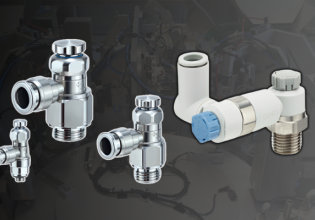Alternative Devices for Measuring Fluid Volume
Flow totalizers, flow sensors, and flow meters are popular devices for measuring flow. However, this article discusses alternative methods, such as ultrasonic level detection and resistive tape.
Flow Totalizer, Flow Sensor, and Flow Meter
Measuring the amount of fluid in a vessel can be done in many ways. In a previous article, I discussed using a flow sensor or flow meter connected to a control system to calculate the total volume that has passed by in a specific amount of time. In this article, I show nontraditional ways to measure the total volume in a vessel instead of a totalizer and flow sensor.
Using the flow rate, we can assume the volume inside a vessel. A flow totalizer, along with a flow sensor, is another way of measuring the amount of flow entering or exiting a vessel. These methods measure the flow in a pipe; if that pipe is connected to a vessel, we can assume the amount of product in or has exited a vessel.
Problems With Volume vs. Flow
One of the problems with using flow to calculate the volume is the sensor’s location. Flow sensors and flow meters require a specific amount of straight pipe upstream and downstream of the process. The industry standard is 10 diameters upstream and five diameters downstream.
These pipe sections cannot have any elbows, tees, or restrictions of any kind. This ensures an accurate measurement of undisturbed flow. Designing this amount of horizontal straight pipe in a system can be problematic.

Figure 1. Using ultrasonic sensors for level detection. Image used courtesy of Banner Engineering
Sometimes, vessels are filled from multiple ports, and having multiple flow sensors or flow meters can become very expensive. Other times, the product flowing through the pipes does not work well with flow meters or is a material that doesn’t interface with the material used in flow meters and sensors.
Luckily, today, we have many different choices when it comes to measuring the volume of a vessel.
Alternative Methods for Volume Detection
Ultrasonic Level Detection
An ultrasonic sensor sends an ultrasonic sound wave and measures the signal’s response time. The longer it takes for the signal to return to the sensor, the further the object. Once we know the product’s level in a vessel, we can determine the volume or percentage of the filled vessel.

Figure 2. How ultrasonic sensors work. Image used courtesy of Keyence
The advantage of using an ultrasonic sensor is it doesn’t matter how corrosive or abrasive the product is—nothing touches the sensor. The downside is the signal is sensitive to temperature, wind, and pressure. Companies such as Hawk Measurement create solutions to this problem, such as using microwave technology. Similar to ultrasonic, microwave signals are not susceptible to temperature or pressure.
Resistive Tape
While ultrasonic sensors are usable in many conditions, they have limitations. If your project doesn’t require an expensive ultrasonic sensor or you have a small amount of fluid to measure, a resistive tape solution might work.
Resistive tape or liquid level tape measures the pressure that the fluid exerts on the tape—much like how a load cell measures the weight of an object resting on it. As the fluid volume increases, so does the pressure on the tape, and electrical resistance is reduced.

Figure 3. Resistive tape. Image used courtesy of Adafruit
By applying a voltage through this resistance and measuring the voltage from the tape, we can determine the volume in the vessel. Some scaling within the control system is required to show a volume in engineering units, but because the change in resistance is linear, we can use the simple y=mx+b formula.
The tape needs to be in the solution to measure the level, so depending on the solution, it may not be compatible with the materials from which the tape is made. Temperature is also a factor; the above example has a temperature rating of -9 °C to 60 °C. Additionally, resistive tape is typically not very long, usually around 400 mm.
Continuous Level Float Sensor
A level float sensor is typically made of reed switches and resistors inside a tube that read the position of a float outside the tube. As the float rises and falls with the level, the resistance within the sensor changes, similar to the level tape.

Figure 4. A continuous level float sensor. Image used courtesy of Innovative Components
Similar scaling is required within the control system. Unlike the level tape, the level float sensor usually has an analog output that can be quickly scaled within a PLC or microcontroller. Most level floats are made of stainless steel, so they will not be affected by the solution they are submerged in. Because of the analog output, float sensors can be easily connected to a panel meter requiring no control system or programming.
Selecting The Right Fluid Measuring Device
There are many different ways to measure volume; this article covers a few.
Ultimately, the project and product type will be the most significant factor when deciding which option to choose. Some sensors are easier to scale and connect to a control system than others.
Whichever method you choose, ensure your control system will read the signal correctly and that the sensor’s accuracy will fit your project’s requirements.






